Syntheses and Characteristics of Urushiol-Based Waterborne UV-Cured Wood Coatings
Abstract
:1. Introduction
2. Materials and Methods
2.1. Materials
2.2. Preparation and Measurement of Epoxide Urushiol (EU) and Acrylic Epoxide Urushiol (AEU)
2.3. Preparation and Measurement of Urushiol-Based Polyurethane Dispersions (PUDs) with Different Diisocyanates
2.4. Preparation of The Urushiol-Based WUV Coatings
2.4.1. Curing Processes of WUV Coatings
2.4.2. Measurements of WUV Film Properties
3. Results and Discussion
3.1. Structure Identification and Characteristics of EU and AEU
3.2. Structure Identification and Molecular Weight of Prepolymers
3.3. Fundamental Properties of PUDs
3.4. Fundamental Properties of WUV Films
4. Conclusions
Author Contributions
Funding
Institutional Review Board Statement
Informed Consent Statement
Data Availability Statement
Conflicts of Interest
References
- Lu, Y.; Tighzert, L.; Berzin, F.; Rondot, S. Innovative plasticized starch films modified with waterborne polyurethane from renewable resources. Carbohydr. Polym. 2005, 61, 174–182. [Google Scholar] [CrossRef]
- Quintero, C.; Mendon, S.K.; Smith, O.W.; Thames, S.F. Miniemulsion polymerization of vegetable oil macromonomers. Prog. Org. Coat. 2006, 57, 195–201. [Google Scholar] [CrossRef]
- Formela1, K.; Zedler, Ł.; Hejna1, A.; Tercjak, A. Reactive extrusion of bio-based polymer blends and composites—Current trends and future developments. Express Polym. Lett. 2018, 12, 24–57. [Google Scholar] [CrossRef]
- Dhillon, R.S.; Wuehlisch, G. Mitigation of global warming through renewable biomass, biomass and bioenergy. Biomass Bioenergy 2013, 48, 75–89. [Google Scholar] [CrossRef]
- Lu, R.; Harigaya, S.; Ishimura, T.; Nagase, K.; Miyakoshi, T. Development of a fast drying lacquer based on raw lacquer sap. Prog. Org. Coat. 2004, 51, 238–243. [Google Scholar] [CrossRef]
- Kumanotani, J. Urushi (oriental lacquer)—A natural aesthetic durable and future-promising coating. Prog. Org. Coat. 1995, 26, 163–195. [Google Scholar] [CrossRef]
- Lu, R.; Yoshida, T.; Miyakoshi, T. Oriental lacquer: A natural polymer. Polym. Rev. 2013, 53, 153–191. [Google Scholar] [CrossRef]
- Wang, C.; Chen, H.; Zhou, H.; Li, W.; Lu, L.; Phuc, B. Investigation and development on processing of Vietnamese lacquer. Adv. Biol. Chem. 2014, 4, 79–85. [Google Scholar] [CrossRef] [Green Version]
- Peisach, J.; Levine, W.G.; Blumberg, W.E. Structural properties of stellacyanin, a copper mucoprotein from Rhus vernicifera, the Japanese lac tree. J. Biol. Chem. 1967, 242, 2847–2858. [Google Scholar] [CrossRef]
- Oshima, R.; Kumanotani, J. Structural studies of plant gum from sap of the lac tree, Rhus vernicifera. Carbohydr. Res. 1984, 127, 43–57. [Google Scholar] [CrossRef]
- Kumanotani, J. Enzyme catalyzed durable and authentic oriental lacquer: A natural microgel-printable coating by polysaccharide–glycoprotein–phenolic lipid complexes. Prog. Org. Coat. 1998, 34, 135–146. [Google Scholar] [CrossRef]
- Watanabe, H.; Fujimoto, A.; Takahara, A. Characterization of catechol-containing natural thermosetting polymer “urushiol” thin film. Polym. Chem. 2013, 51, 3688–3692. [Google Scholar] [CrossRef]
- Symes, W.F.; Dawson, C.R. Poison ivy “urushiol”. J. Am. Chem. Soc. 1954, 76, 2959–2963. [Google Scholar] [CrossRef]
- Yang, J.; Deng, J.; Shen, Q.; Li, D.; Xiao, Z. Effects of polysaccharides on the properties of Chinese lacquer sap. Prog. Org. Coat. 2015, 78, 176–182. [Google Scholar] [CrossRef]
- Liu, T.; Xia, J.; Lin, J. Characterization and conductive property of polyurushiol/silver conductive coatings prepared under UV irradiation. Prog. Org. Coat. 2011, 71, 117–120. [Google Scholar] [CrossRef]
- Lu, R.; Wang, Y.Y.; Honda, T.; Ishimura, T.; Kamiya, Y.; Miyakoshi, T. Design and characterization of modified urethane lacquer coating. Prog. Org. Coat. 2006, 57, 215–222. [Google Scholar] [CrossRef]
- Niimura, N.; Miyakoshi, T.; Onodera, J.; Higuchi, T. Structural studies and polymerization mechanisms of synthesized lacquer films using two-stage pyrolysis-gas chromatography/mass spectrometry. Int. J. Polym. Anal. Ch. 1998, 4, 309–322. [Google Scholar] [CrossRef]
- Zheng, X.; Weng, J.; Li, S.; Liu, H.; Hu, B.; Li, Y.; Meng, X.; Ruan, H. Anticorrosive ultrathin film derived from bio-based urushiol–Ti by layer-by-layer self-assembly. Chem. Eng. J. 2014, 245, 265–275. [Google Scholar] [CrossRef]
- Xia, J.; Lin, J.; Xu, Y.; Chen, Q. On the UV-induced polymeric behavior of Chinese lacquer. ACS Appl. Mater. Interfaces 2011, 3, 482–489. [Google Scholar] [CrossRef] [PubMed]
- Watanabe, H.; Fujimoto, A.; Yamamoto, R.; Nishida, J.; Kobayashi, M.; Takahara, A. Scaffold for growing dense polymer brushes from a versatile substrate. ACS Appl. Mater. Interfaces 2014, 6, 3648–3653. [Google Scholar] [CrossRef] [PubMed]
- Zhang, L.; Wu, H.T.; Zheng, Z.Y.; He, H.C.; Wei, M.; Huang, X.H. Fabrication of graphene oxide/multi-walled carbon nanotube/urushiol formaldehyde polymer composite coatings and evaluation of their physico-mechanical properties and corrosion resistance. Prog. Org. Coat. 2019, 127, 131–139. [Google Scholar] [CrossRef]
- Xu, H.; Lu, Z.; Zhang, G. Synthesis and properties of thermosetting resin based on urushiol. RSC Adv. 2012, 2, 2768–2772. [Google Scholar] [CrossRef]
- Kim, D.; Jeon, S.L.; Seo, J. The preparation and characterization of urushiol powders (YPUOH) based on urushiol. Prog. Org. Coat. 2013, 76, 1465–1470. [Google Scholar] [CrossRef]
- Xiao, X.; Hao, C. Preparation of waterborne epoxy acrylate/silica sol hybrid materials and study of their UV curing behavior. Colloids Surf. A Physicochem. Eng. Asp. 2010, 359, 82–87. [Google Scholar] [CrossRef]
- Xu, H.; Yang, D.; Guo, Q.; Wang, Y.; Wu, W.; Qiu, F. Waterborne polyurethane-acrylate containing different polyether polyols: Preparation and properties. Polym. Plast. Technol. Eng. 2012, 51, 50–57. [Google Scholar] [CrossRef]
- Jung, S.J.; Lee, S.J.; Cho, W.J.; Ha, C.S. Synthesis and properties of UV-curable waterborne unsaturated polyester for wood coating. J. Appl. Polym. Sci. 1998, 69, 695–708. [Google Scholar] [CrossRef]
- Bai, C.Y.; Zhang, X.Y.; Dai, J.B. Synthesis and characterization of PDMS modified UV curable waterborne polyurethane dispersions for soft tact layers. Prog. Org. Coat. 2007, 60, 63–68. [Google Scholar] [CrossRef]
- Zhang, S.W.; Liu, R.; Jiang, J.Q.; Yang, C.; Chen, M.; Liu, X.Y. Facile synthesis of waterborne UV-curable polyurethane/silica nanocomposites and morphology, physical properties of its nanostructured films. Prog. Org. Coat. 2011, 70, 1–8. [Google Scholar] [CrossRef]
- Dillman, B.F.; Kang, N.Y.; Jessop, J.L.P. Solventless synthesis and free-radical photopolymerization of a castor oil-based acrylate oligomer. Polymer 2013, 54, 1768–1774. [Google Scholar] [CrossRef]
- CNS 9007. Method of Test for Paints-Sampling and General Condition; CNS: Taipei, Taiwan, 1995. [Google Scholar]
- ASTM D1652-90. Annual Book of ASTM Standards; ASTM: West Conshohocken, PA, USA, 1990. [Google Scholar]
- CNS13568 K0058. Method of Test for Acid Value, Saponification Value, Ester Value, Iodine Value, Hydroxyl Value and Unsaponificable Matter of Chemical Products; CNS: Taipei, Taiwan, 1995. [Google Scholar]
- CNS 5133. Method of Determination for Nonvolatile Content of Adhesives; CNS: Taipei, Taiwan, 1980. [Google Scholar]
- CNS 10756 K6800. Method of Test for Paints (Film Formability of Paints); CNS: Taipei, Taiwan, 1994. [Google Scholar]
- JIS K 5400. Testing Methods for Paints; Japanese Standards Association: Tokyo, Japan, 1990. [Google Scholar]
- Honda, T.; Lu, R.; Sakai, R.; Ishimura, T.; Miyakoshi, T. Characterization and comparison of Asian lacquer saps. Prog. Org. Coating. 2008, 61, 68–75. [Google Scholar] [CrossRef]
- Ishimura, T.; Yoshida, T. Polymerization of oriental lacquer (urushi) with epoxidized linseed oil as a new reactive diluent. Int. J. Polym. Sci. 2015, 1–4, 1–7. [Google Scholar] [CrossRef] [Green Version]
- Xia, Z.; Miyakoshi, T.; Yoshida, T. Lipoxygenase-catalyzed polymerization of phenolic lipids suggests a new mechanism for allergic contact dermatitis induced by urushiol and its analogs. Biochem. Biophys. Res. Commun. 2004, 315, 704–709. [Google Scholar] [CrossRef] [PubMed]
- Zhan, F.; Cheng, X.; Shi, W. Synthesis and properties of oxetane-based polysiloxanes used for cationic UV curing coatings. Polym. Adv. Technol. 2012, 23, 645–651. [Google Scholar] [CrossRef]
- Wang, X.M.; Li, Q. A new method for preparing low viscosity and high solid content waterborne polyurethane—Phase inversion research. Prog. Org. Coat. 2019, 131, 285–290. [Google Scholar] [CrossRef]
- Ma, X.Y.; Zhang, W.D. Effects of flower-like ZnO nanowhiskers on the mechanical, thermal and antibacterial properties of waterborne polyurethane. Polym. Degrad. Stab. 2009, 94, 1103–1109. [Google Scholar] [CrossRef]
- Fang, C.; Zhou, X.; Yu, Q.; Liu, S.; Guo, D.; Yu, R.; Hu, J. Synthesis and characterization of low crystalline waterborne polyurethane for potential application in water-based ink binder. Prog. Org. Coat. 2014, 77, 61–71. [Google Scholar] [CrossRef]
- Girouard, N.; Xu, S.; Schueneman, G.; Shofner, M.; Meredith, J. Site-selective modification of cellulose nanocrystals with isophorone diisocyanate and formation of polyurethane-CNC composites. ACS Appl. Mater. Interfaces 2016, 8, 1458–1467. [Google Scholar] [CrossRef] [PubMed]
- Lu, Y.; Larock, R.C. Soybean oil-based, aqueous cationic polyurethane dispersions: Synthesis and properties. Prog. Org. Coat. 2010, 69, 31–37. [Google Scholar] [CrossRef]
- Ley, D.A.; Fiori, D.E.; Quinn, R.J. Optimization of acrylic polyols for low VOC two-component water reducible polyurethane coatings using tertiary isocyanate crosslinkers. Prog. Org. Coat. 1999, 35, 109–116. [Google Scholar] [CrossRef]
- Nanda, A.K.; Wicks, D.A.; Madbouly, S.A.; Otaigbe, J.U. Effect of ionic content, solid content, degree of neutralization, and chain extension on aqueous polyurethane dispersions prepared by prepolymer method. J. Appl. Polym. Sci. 2005, 98, 2514–2520. [Google Scholar] [CrossRef]
- Shendi, H.K.; Omrani, I.; Ahmadi, A.; Farhadian, A.; Babanejad, N.; Nabid, M.R. Synthesis and characterization of a novel internal emulsifier derived from sunflower oil for the preparation of waterborne polyurethane and their application in coatings. Prog. Org. Coat. 2017, 105, 303–309. [Google Scholar] [CrossRef]
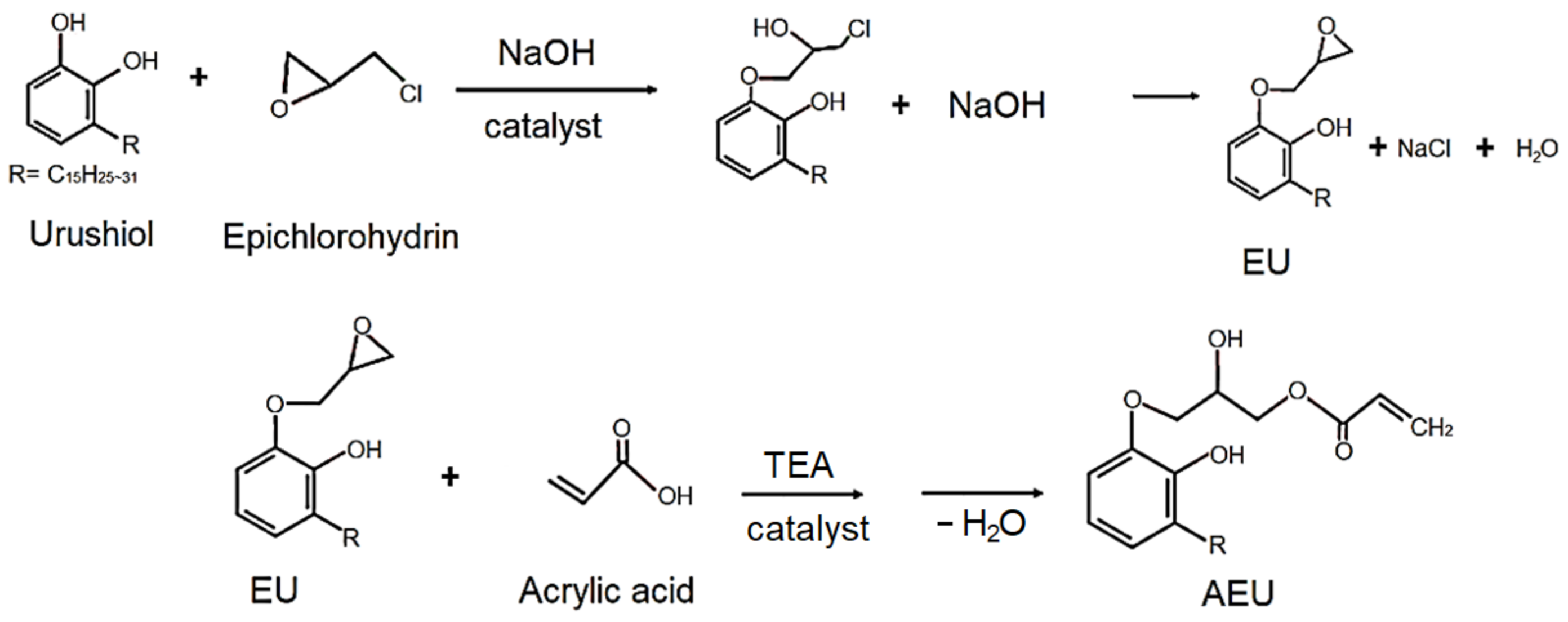
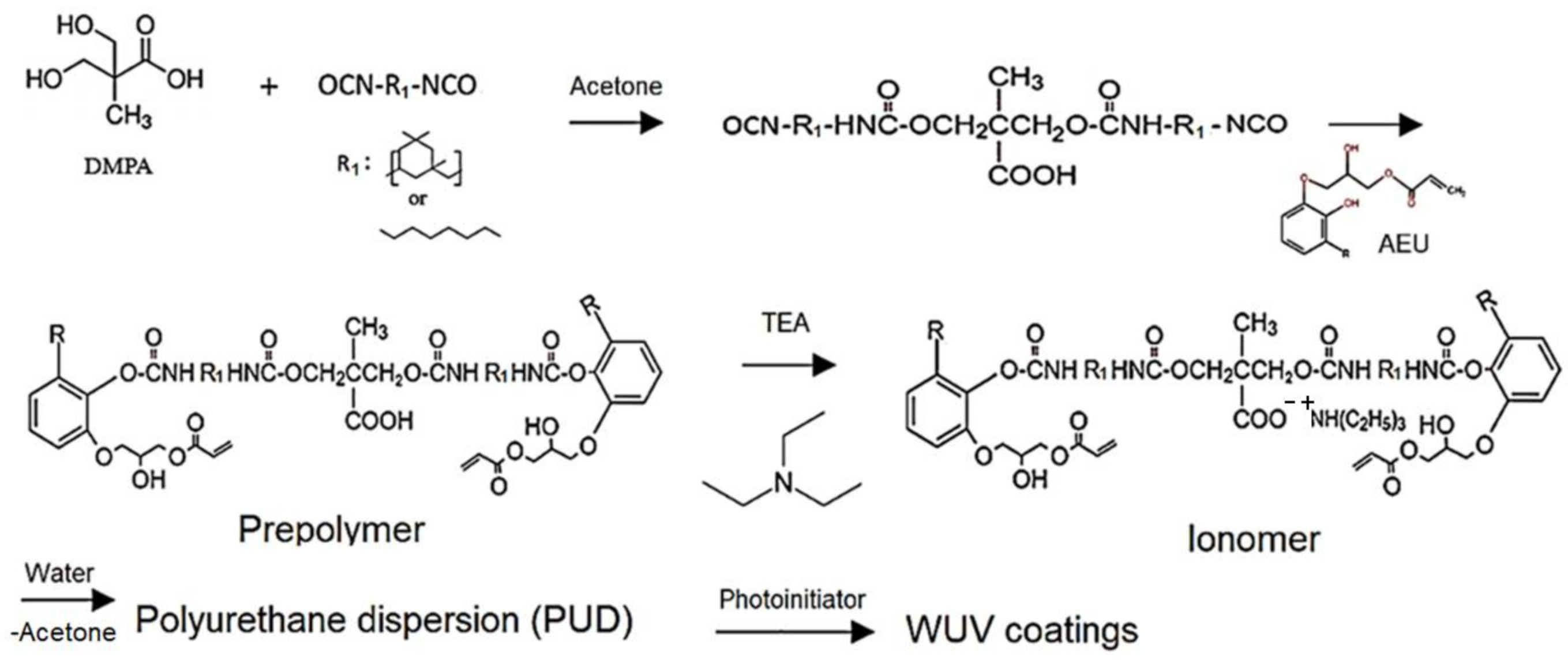
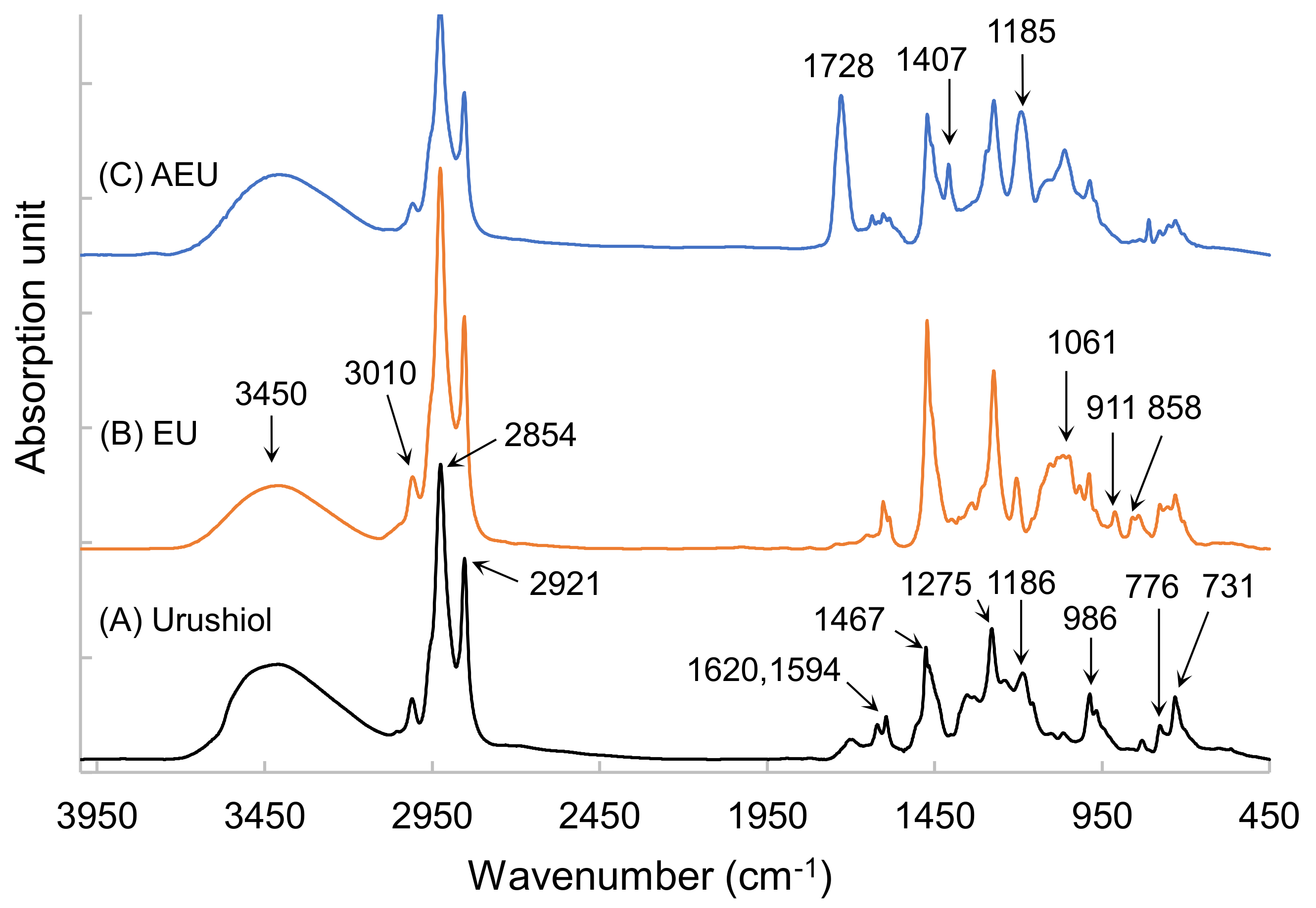
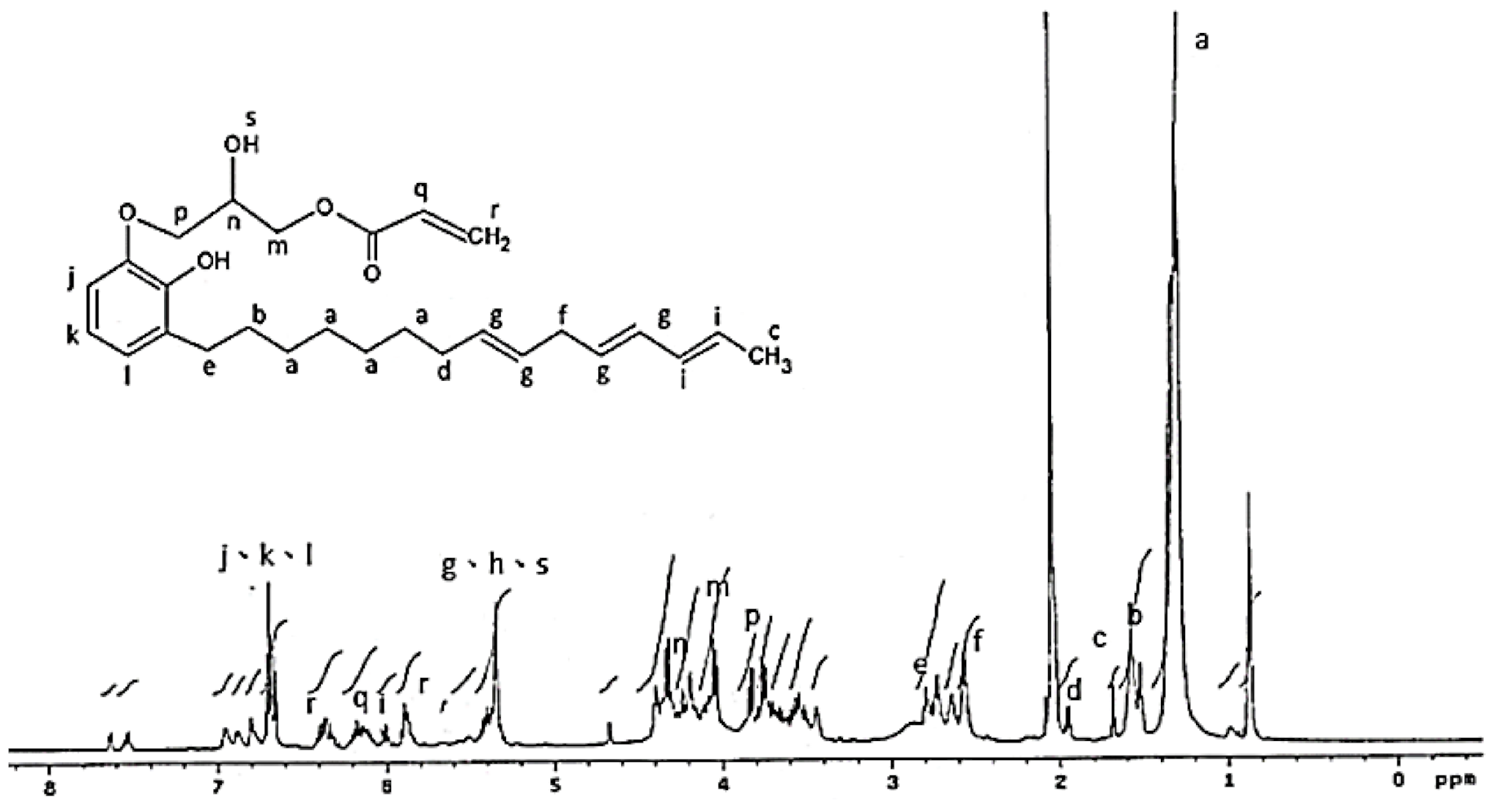


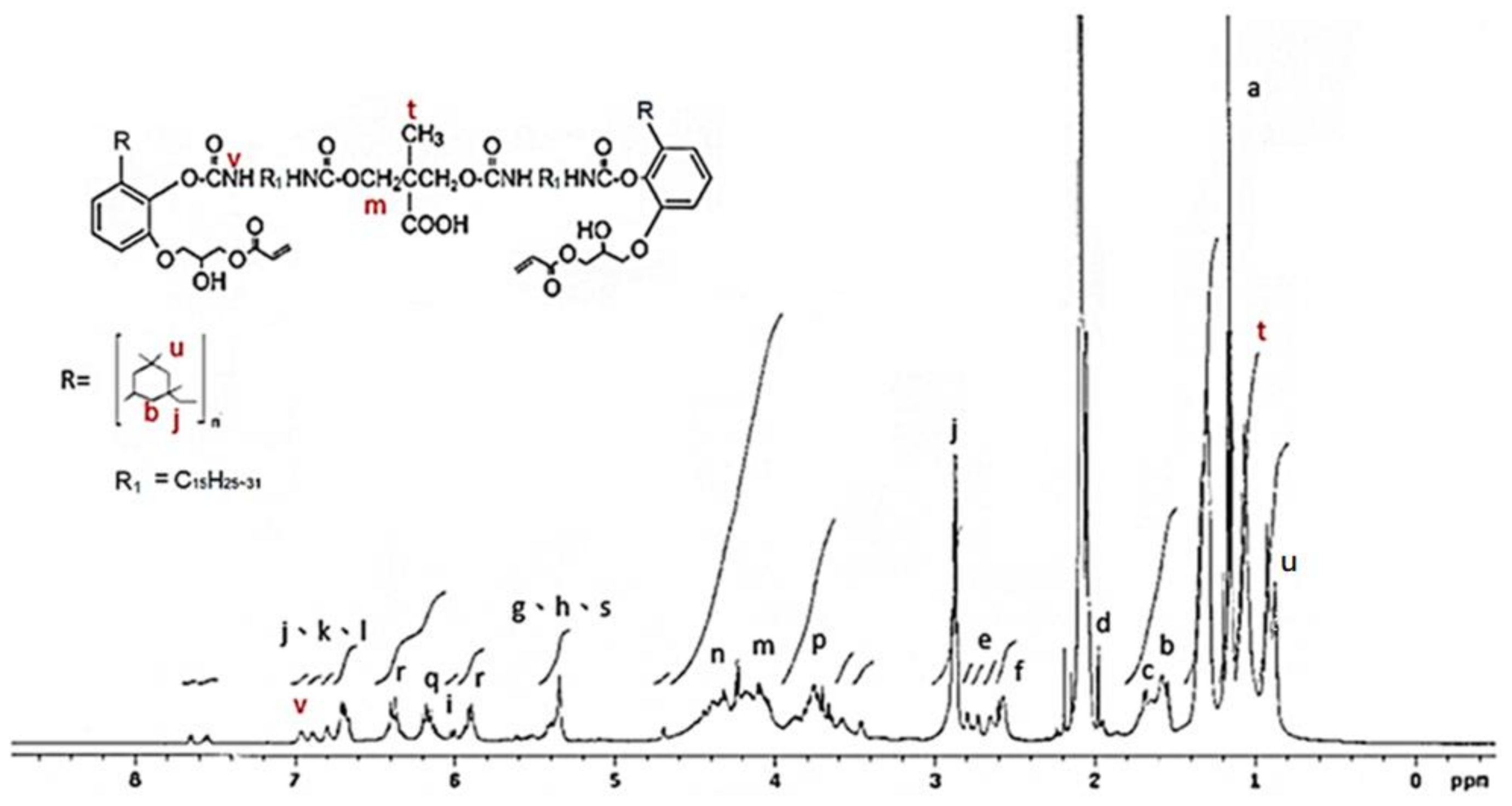

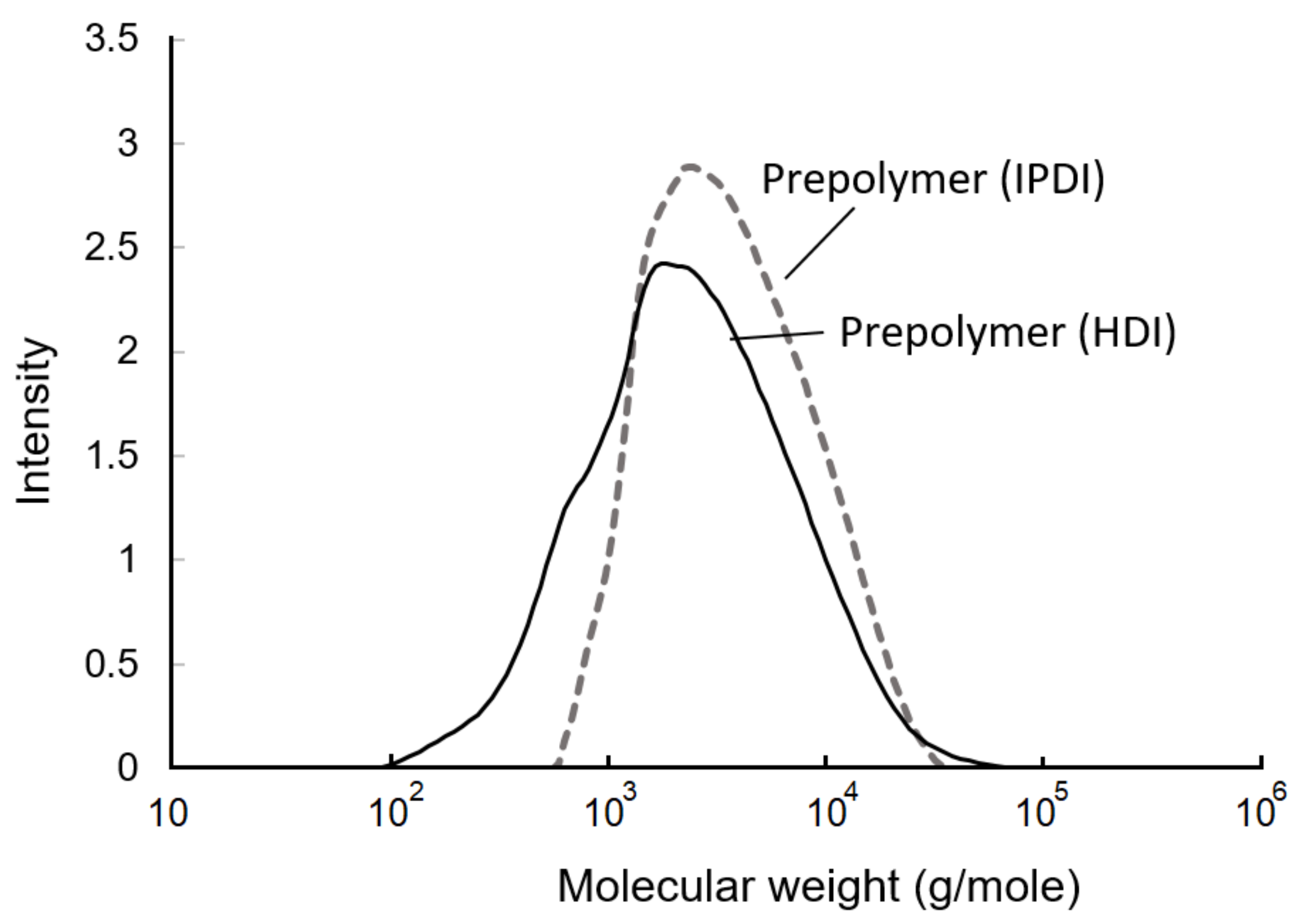
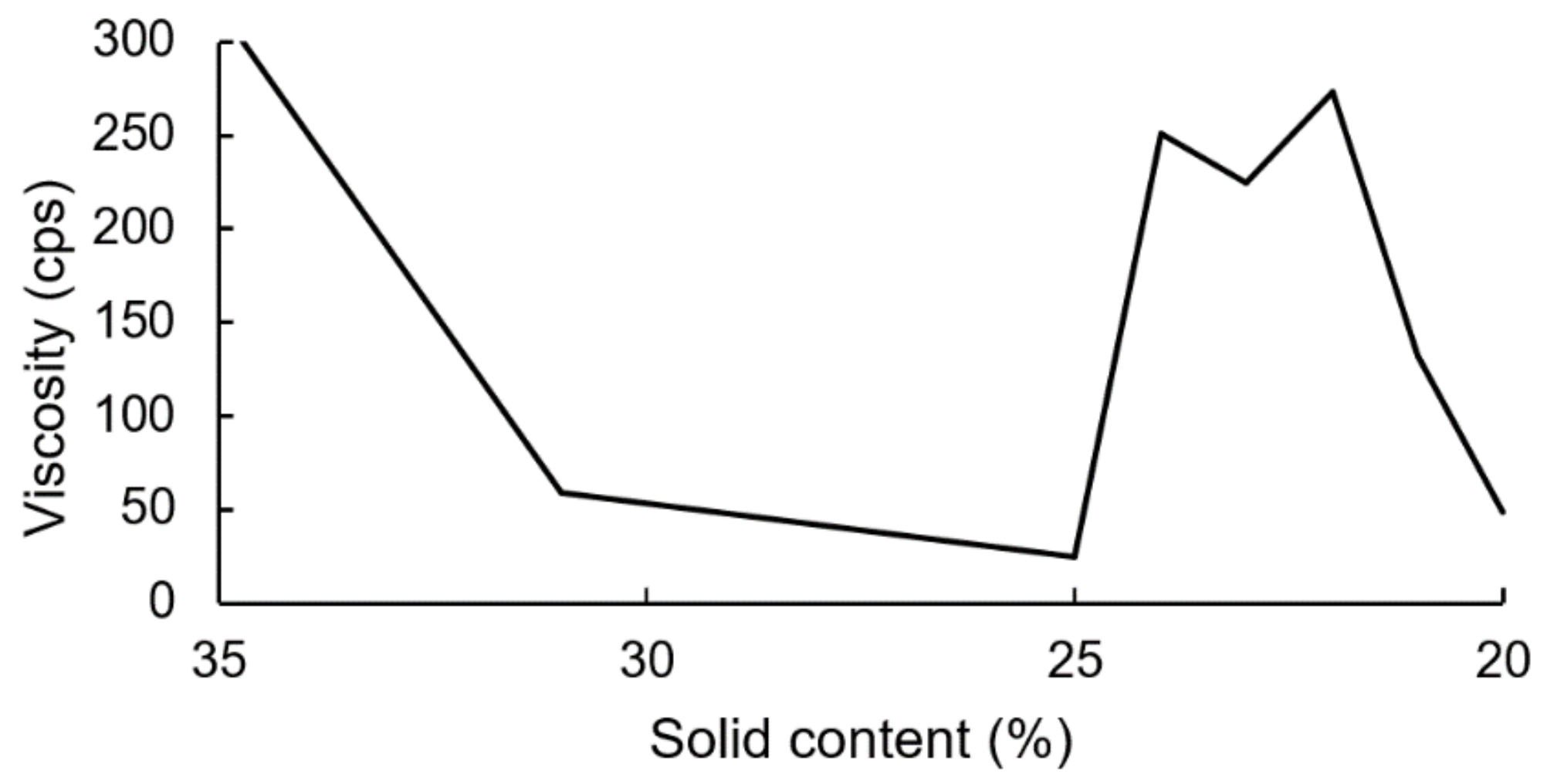
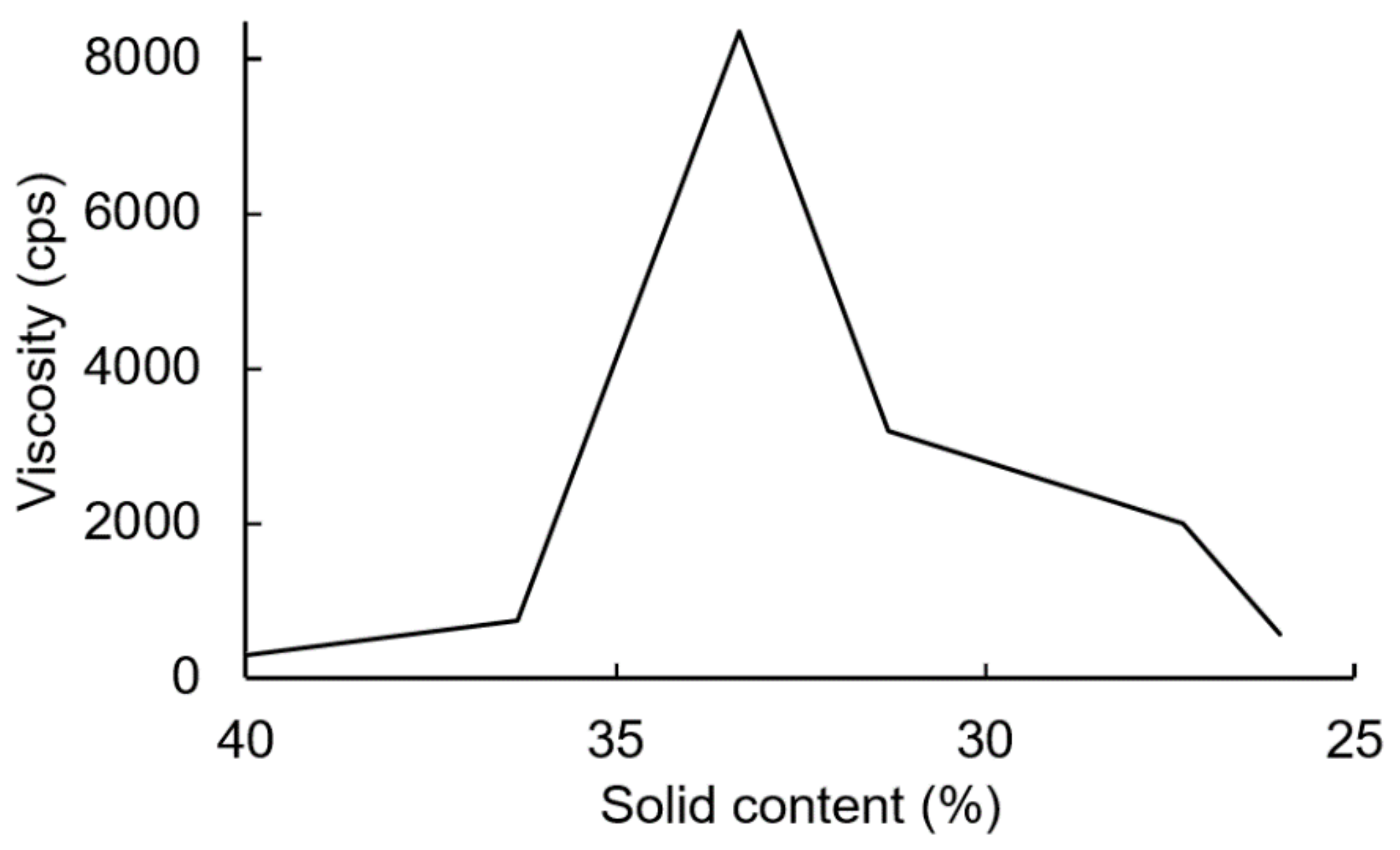

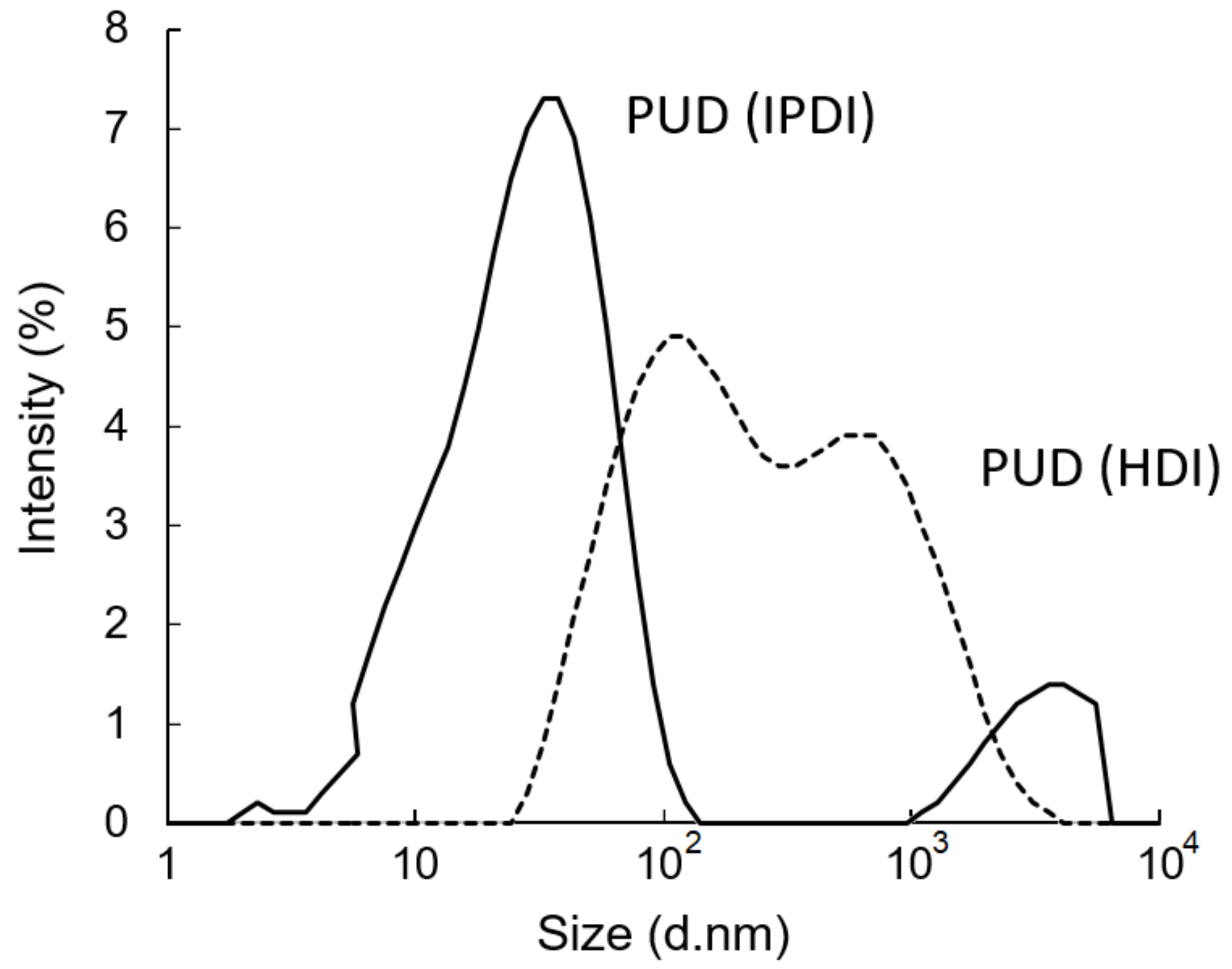
| Prepolymers | Mw (g/mole) | Mn (g/mole) | Polydispersity (Mw/Mn) |
|---|---|---|---|
| IPDI | 4583 | 2535 | 1.8 |
| HDI | 3657 | 1390 | 2.6 |
| PUDs | Viscosity (cps) | Solid Content (%) | pH Value | Z-Average Particle Size (nm) | PDI |
|---|---|---|---|---|---|
| IPDI | 100 | 25.2 | 7.8 | 80 | 0.217 |
| HDI | 2000 | 26.2 | 7.6 | 158 | 0.524 |
| WUV Films | Hardness (König, S) | Mass Retention (%) | Impact Resistance (300 g, cm) | Adhesion (Grade) | Bending Resistance (mm) | 20° Gloss (GU) | Lightfastness (after 200 h Irradiation) | |
|---|---|---|---|---|---|---|---|---|
| ΔE* | ΔYI | |||||||
| IPDI | 131 ± 4 | 53 ± 2 | 5 | 8 | <2 | 100 ± 4 | 0.99 | 1.87 |
| HDI | 41 ± 3 | 51 ± 5 | 10 | 8 | <2 | 84 ± 3 | 2.00 | 3.93 |
Publisher’s Note: MDPI stays neutral with regard to jurisdictional claims in published maps and institutional affiliations. |
© 2021 by the authors. Licensee MDPI, Basel, Switzerland. This article is an open access article distributed under the terms and conditions of the Creative Commons Attribution (CC BY) license (https://creativecommons.org/licenses/by/4.0/).
Share and Cite
Chang, C.-W.; Liao, J.-Y.; Lu, K.-T. Syntheses and Characteristics of Urushiol-Based Waterborne UV-Cured Wood Coatings. Polymers 2021, 13, 4005. https://doi.org/10.3390/polym13224005
Chang C-W, Liao J-Y, Lu K-T. Syntheses and Characteristics of Urushiol-Based Waterborne UV-Cured Wood Coatings. Polymers. 2021; 13(22):4005. https://doi.org/10.3390/polym13224005
Chicago/Turabian StyleChang, Chia-Wei, Jyun-Ya Liao, and Kun-Tsung Lu. 2021. "Syntheses and Characteristics of Urushiol-Based Waterborne UV-Cured Wood Coatings" Polymers 13, no. 22: 4005. https://doi.org/10.3390/polym13224005







